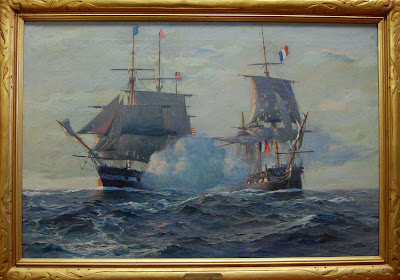Artifact Spotlight: The Newport Poor House, 1819
---Jen Nason, Curatorial Assistant
Before Founders Hall became home to the museum in 1978, it was the original site of the Naval War College. The college occupied the building from 1884 until 1892 when a new structure (later named Luce Hall) was completed. It was here that Alfred Thayer Mahan gave his lectures on naval history and tactics that formed the basis for his seminal book, The Influence of Sea Power Upon History,1660-1783, published in 1890. As the site of these lectures, the building was named a national historic landmark in 1964. However, Founders Hall had a long history as an asylum for the poor and mentally challenged prior its occupation by the United States Navy. On 25 June 1819 Newporters laid the cornerstone for the Asylum for the Deaf and Dumb on Coasters Harbor Island. Truly, this 193-year-old building is the museum's primary artifact.
In March 1819, citizens at a town meeting decided that an asylum or poor house, was to be built for Newport on Coasters Harbor Island. Benjamin Chase constructed the building using local field stone. The main building consisted of a kitchen, storeroom, and closets in the basement. Housing was on the first and second floors, while a large room for assemblies and religious services was on the third floor.
The people that resided at the asylum were of varied backgrounds. Some people were poor with no means of supporting themselves, some were orphaned children, some were declared insane, while others were petty criminals. Despite these different conditions, they all lived under the same rules and regulations enforced by an overseer. The occupants were all given work to perform: some cleaned the asylum, others tended a successful farm, and the orphaned children attended a school within the building. There were also designated meal times, washing times, and days of worship. Visitors were allowed once a week and contact between the men and women was forbidden. Inmates who failed to comply with the overseer were punished. The harshest punishments included incarceration in small cage on the first floor. On occasion, the overseer would lock those who were declared insane in these solitary cages permanently. There were at times up to sixty people at the asylum, yet they must have felt an intense amount of loneliness and frustration. It was not until the 1850s that a bridge was constructed to link the town of Newport to the island, and even then the bridge was two miles away from the center of town.
After the 1850s, Newport created a larger jail in which to place its criminals and the state established another asylum in Cranston for the "insane." Still, the poor and orphaned remained within the Newport poor house until the 1880s when the island was transferred to the U.S. Navy. During that time, the ideal of institutionalization started to fade away. The facilities of the asylum had improved to incorporate new technologies, and the living quarters had been enlarged. Yet, a separate orphanage was constructed in Newport, and the asylum’s poor dwindled down to about twenty people. Those who remained moved into a small building on Broadway Road in Newport. In October of 1884, Commodore Stephen B. Luce climbed the steps of the old asylum, and reportedly announced, "Poor little poorhouse, I christen thee United States Naval War College." Not long after, Alfred Thayer Mahan began his historic lectures on naval history and tactics to the first class of naval officers. The cornerstone laid on 25 June 1819, along with Mahan's lectures, formed the basis for the museum's local, national, and international focus.
Images courtesy of the Naval War College Museum
 |
| The Naval War College, c. 1884 |
Images courtesy of the Naval War College Museum



Comments
Post a Comment